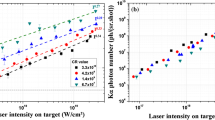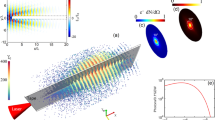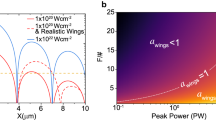Abstract
The classical Rayleigh–Taylor (R–T) instability of a fluid supporting a higher-density fluid1,2 in a gravitational field is expected to occur in laser-driven compression3. A laser produces a high-pressure plasma that accelerates a higher-density solid shell of thickness Δr at a rate a. The effective gravitational acceleration–a would cause shell perturbations of wavenumber k to grow at the R–T rate γ = (ka)½. However, ablation effects3–5 are predicted to damp short-wavelength modes, giving rise to a maximum growth rate at k ∼ 1/Δr and implying a maximum aspect ratio r/Δr for a stable implosion. We present here the first clear experimental evidence for the growth of the R–T instability in a laser-accelerated plane target. These results were obtained by a novel technique using a target with an initial corrugation of known k. Streak X-ray radiography allows direct measurement of the growth of mass modulations in the target caused by this initial perturbation. The time-averaged growth rate of an imposed perturbation is measured as (0.3±0.05) × (ka)½, in close agreement with a numerical simulation.
This is a preview of subscription content, access via your institution
Access options
Subscribe to this journal
Receive 51 print issues and online access
$199.00 per year
only $3.90 per issue
Buy this article
- Purchase on Springer Link
- Instant access to full article PDF
Prices may be subject to local taxes which are calculated during checkout
Similar content being viewed by others
References
Lord Rayleigh, Theory of Sound 2nd edn, Vol. 2 (Dover, New York, 1945).
Taylor, G. I. Proc. R. Soc. A201, 192 (1930).
Nuckolls, J. H., Wood, L., Thiessen, A. & Zimmerman, G. Nature 239, 139 (1972).
McCrory, R. L., Monteith, L., Morse, R. L. & Verdon, C. P. Phys. Rev. Lett. 46, 336 (1981).
Emery, M. H., Gardner, J. H. & Boris, J. P. Phys. Rev. Lett. 48, 677 (1982).
Ross, I. et al. IEEE J. Quant. Elect. QE 17, 1653 (1981).
Goldsack, T. J. et al. Opt. Commun. 42, 55 (1982).
Lindl, J. D. & Mead, W. C. Phys. Rev. Lett. 34, 1273 (1975).
Pert, G. J. comp. Phys. 43, 111 (1981).
Author information
Authors and Affiliations
Rights and permissions
About this article
Cite this article
Cole, A., Kilkenny, J., Rumsby, P. et al. Measurement of Rayleigh–Taylor instability in a laser-accelerated target. Nature 299, 329–331 (1982). https://doi.org/10.1038/299329a0
Received:
Accepted:
Issue Date:
DOI: https://doi.org/10.1038/299329a0
This article is cited by
-
Laboratory evidence for proton energization by collisionless shock surfing
Nature Physics (2021)
-
Numerical investigation of a single-mode chemically reacting Richtmyer-Meshkov instability
Shock Waves (2015)
-
Polychromatic X-ray Beam from the Acceleration of Energetic Electrons in Ultrafast Laser-Produced Plasmas
Astrophysics and Space Science (2007)
-
Laser fusion: Hollow shells, shorter wavelengths
Nature (1985)
Comments
By submitting a comment you agree to abide by our Terms and Community Guidelines. If you find something abusive or that does not comply with our terms or guidelines please flag it as inappropriate.



